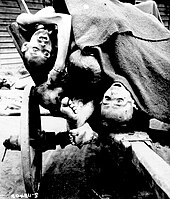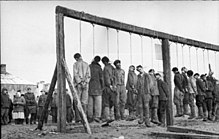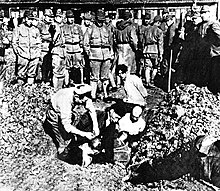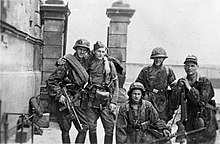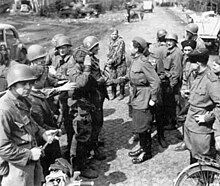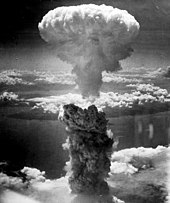Course of the war
War breaks out in Europe
On 1 September 1939, Germany and
Slovakia—a client state in 1939—
attacked Poland. On 3 September 1939 after Germany failed to withdraw in accordance with French and British demands, France and Britain, followed by the countries of the
Commonwealth, declared war on Germany but provided little military support to Poland other than a
small French attack into the Saarland.
On 17 September 1939, after signing a
nonaggression pact with Japan, the
Soviets launched their own invasion of Poland.
By early October, Poland was divided among
Germany,
the Soviet Union,
Lithuania and
Slovakia, although Poland never officially surrendered and
continued the fight outside its borders.
At the same time as the battle in Poland, Japan launched its
first attack against Changsha, a strategically important Chinese city, but was repulsed by late September.
Following the invasion of Poland and a
German-Soviet treaty governing Lithuania, the Soviet Union forced the
Baltic countries to allow it
to station Soviet troops in their countries under pacts of "mutual assistance." Finland rejected territorial demands and was invaded by the Soviet Union in November 1939.
The
resulting conflict ended in March 1940 with
Finnish concessions.
France and the United Kingdom, treating the Soviet attack on Finland as tantamount to entering the war on the side of the Germans, responded to the Soviet invasion by supporting the USSR's expulsion from the League of Nations.
In Western Europe, British troops deployed to the Continent, but in a phase nicknamed the
Phoney War by the British and "Sitzkrieg" (
sitting war) by the Germans, neither side launched major operations against the other until April 1940.
The Soviet Union and Germany entered a
trade pact in February 1940, pursuant to which the Soviets received German military and industrial equipment in exchange for supplying raw materials to Germany to help circumvent a British blockade.
In April 1940,
Germany invaded Denmark and Norway to secure shipments of
iron ore from Sweden, which the Allies were
about to disrupt.
Denmark immediately capitulated, and
despite Allied support,
Norway was conquered within two months.
In May 1940
Britain invaded Iceland.
British discontent over the Norwegian campaign led to the replacement of Prime Minister
Neville Chamberlain by
Winston Churchill on 10 May 1940.
Axis advances
Germany
invaded France,
Belgium,
the Netherlands, and
Luxembourg on 10 May 1940, the same day
Neville Chamberlain resigned as
British Prime Minister.
The
Netherlands and
Belgium were overrun using
blitzkrieg tactics in a few days and weeks, respectively.
The French fortified
Maginot Line was circumvented by a flanking movement through the thickly wooded
Ardennes region,
mistakenly perceived by French planners as an impenetrable natural barrier against armoured vehicles.
British troops were forced to
evacuate the continent at Dunkirk, abandoning their heavy equipment by the end of the month. On 10 June,
Italy invaded France, declaring war on both France and the United Kingdom;
twelve days later
France surrendered and was soon divided into
German and
Italian occupation zones,
and an unoccupied
rump state under the
Vichy Regime. On 3 July, the British
attacked the French fleet in
Algeria to prevent its possible seizure by Germany.
In June, during the last days of the Battle of France, the Soviet Union initiated staged elections in the Baltic states and
forcefully and illegally annexed them,
followed by the annexation of the region of
Bessarabia in
Romania. Whereas the increased cooperation between the USSR and Nazi Germany, which included broad economic cooperation, limited military assistance,
population exchange and
border agreements made the former a
de facto German ally,
Soviet takeover of the Baltic states, Bessarabia and North Bukovina had been seen with dismay and disquiet by Germany,
This, as well as growing tensions over spheres of influence demonstrated impossibility of further expansion of Nazi-Soviet cooperation, and both states had begun the countdown to war.
With France neutralized, Germany began an
air superiority campaign over Britain (the
Battle of Britain) to prepare for
an invasion.
The campaign failed, and the invasion plans were canceled by September. Using newly captured French ports, the German Navy
enjoyed success against an over-extended
Royal Navy, using
U-boats against British shipping in the
Atlantic.
Italy began operations in the Mediterranean, initiating a
siege of Malta in June,
conquering British Somaliland in August, and
making an incursion into British-held Egypt in September 1940. Japan increased its blockade of China in September by
seizing several bases in the northern part of the now-isolated
French Indochina.
Throughout this period, the neutral United States took measures to assist China and the Western Allies. In November 1939, the American Neutrality Act was amended to allow
'cash and carry' purchases by the Allies.
In 1940, following the German capture of
Paris, the size of the
United States Navy was
significantly increased and, after the Japanese incursion into Indochina, the United States
embargoed iron, steel and mechanical parts against Japan.
In September, the United States further agreed to a
trade of American destroyers for British bases.
Still, a large majority of the American public continued to oppose any direct military intervention into the conflict well into 1941.
At the end of September 1940, the
Tripartite Pact united Japan, Italy and Germany to formalize the
Axis Powers.
The Tripartite Pact stipulated that any country, with the exception of the Soviet Union, not in the war which attacked any Axis Power would be forced to go to war against all three.
During this time, the United States continued to support the United Kingdom and China by introducing the
Lend-Lease policy authorizing the provision of materiel and other items
and creating a security zone spanning roughly half of the Atlantic Ocean where the
United States Navy protected British convoys.
As a result, Germany and the United States found themselves engaged in sustained naval warfare in the North and Central Atlantic by October 1941, even though the United States remained officially neutral.
The Axis expanded in November 1940 when
Hungary,
Slovakia and
Romania joined the Tripartite Pact.
These countries participated in the subsequent
invasion of the USSR, with Romania making the
largest contribution to recapture
territory ceded to the USSR and pursue its leader
Ion Antonescu's desire to combat communism.
In October 1940,
Italy invaded Greece but within days was repulsed and pushed back into Albania, where a stalemate soon occurred.
In December 1940, British Commonwealth forces began counter-offensives against
Italian forces in Egypt and
Italian East Africa.
By early 1941, with Italian forces having been pushed back into Libya by the Commonwealth, Churchill ordered a
dispatch of troops from Africa to bolster the Greeks.
The
Italian Navy also suffered significant defeats, with the Royal Navy putting three Italian battleships out of commission by
carrier attack at Taranto, and neutralising several more warships at
Cape Matapan.
The Germans soon intervened to assist Italy. Hitler
sent German forces to Libya in February, and by the end of March they had
launched an offensive against the diminished Commonwealth forces.
In under a month, Commonwealth forces were pushed back into Egypt with the exception of the
besieged port of Tobruk.
The Commonwealth
attempted to dislodge Axis forces in May and
again in June, but failed on both occasions.
In early April, following
Bulgaria's signing of the Tripartite Pact, the Germans intervened in the Balkans
by invading Greece and
Yugoslavia following a coup; here too they made rapid progress, eventually forcing the Allies to evacuate after Germany
conquered the Greek island of Crete by the end of May.
The Allies did have some successes during this time. In the
Middle East, Commonwealth forces first
quashed a coup in Iraq which had been supported by German aircraft from bases within Vichy-controlled
Syria,
then, with the assistance of the
Free French,
invaded Syria and Lebanon to prevent further such occurrences.
In the Atlantic, the British scored a much-needed public morale boost by
sinking the German flagship Bismarck.
Perhaps most importantly, during the Battle of Britain the
Royal Air Force had successfully resisted the Luftwaffe's assault, and the German bombing campaign largely ended in May 1941.
In Asia, despite several offensives by both sides, the war between China and Japan was stalemated by 1940. In order to increase pressure on China by blocking supply routes, and to better position Japanese forces in the event of a war with the Western powers, Japan had
seized military control of southern Indochina In August of that year,
Chinese communists launched an
offensive in Central China; in retaliation, Japan instituted harsh measures (the
Three Alls Policy) in occupied areas to reduce human and material resources for the communists.
Continued antipathy between Chinese communist and nationalist forces
culminated in armed clashes in January 1941, effectively ending their co-operation.
With the situation in Europe and Asia relatively stable, Germany, Japan, and the Soviet Union made preparations. With the Soviets wary of mounting tensions with Germany and the Japanese planning to take advantage of the European War by seizing resource-rich European possessions in Southeast Asia, the two powers signed the
Soviet–Japanese Neutrality Pact in April 1941.
By contrast, the Germans were steadily making preparations for an attack on the Soviet Union, amassing forces on the Soviet border.
The war becomes global
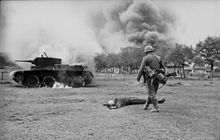
A German soldier inspecting the remains of destroyed Soviet forces in June 1941
On 22 June 1941, Germany, along with other European Axis members and Finland, invaded the Soviet Union in
Operation Barbarossa. The primary targets of this surprise offensive
were the
Baltic region,
Moscow and
Ukraine, with an
ultimate goal of ending the 1941 campaign near the
Arkhangelsk-Astrakhan line, connecting the
Caspian and
White Seas. Hitler's objectives were to eliminate the Soviet Union as a military power, exterminate
Communism, generate
Lebensraum ("living space")
by
dispossessing the native population and guarantee access to the strategic resources needed to defeat Germany's remaining rivals.
Although the
Red Army was preparing for strategic
counter-offensives before the war,
Barbarossa forced the
Soviet supreme command to adopt a
strategic defence. During the summer, the Axis made significant gains into Soviet territory, inflicting immense losses in both personnel and materiel. By the middle of August, however, the German
Army High Command decided to
suspend the offensive of a considerably depleted
Army Group Centre, and to divert the
Second Panzer Group to reinforce troops advancing towards central Ukraine and Leningrad.
The
Kiev offensive was overwhelmingly successful, resulting in encirclement and elimination of four Soviet armies, and made further
advance into Crimea and industrially developed Eastern Ukraine (the
First Battle of Kharkov) possible.
The diversion of three quarters of the Axis troops and the majority of their air forces from France and the central Mediterranean to the
Eastern Front prompted Britain to reconsider its grand strategy.
In July, the UK and the Soviet Union formed a
military alliance against Germany The British and Soviets
invaded Iran to secure the
Persian Corridor and Iran's
oil fields.
In August, the United Kingdom and the United States jointly issued the
Atlantic Charter.
By October, when Axis operational objectives in Ukraine and the Baltic region were achieved, with only the sieges of
Leningrad and
Sevastopol continuing,
a major
offensive against Moscow had been renewed. After two months of fierce battles, the German army almost reached the outer suburbs of Moscow, where the exhausted troops
were forced to suspend their offensive.
Large territorial gains were made by Axis forces, but their campaign had failed to achieve its main objectives: two key cities remained in Soviet hands, the Soviet
capability to resist was not broken, and the Soviet Union retained a considerable part of its military potential. The
blitzkrieg phase of the war in Europe had ended.
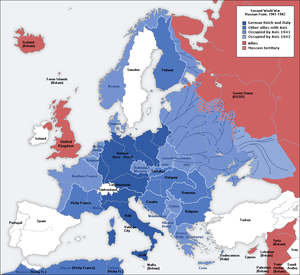
The Axis controlled territory in Europe at the time of its maximal expansion (1941–42).
By early December, freshly mobilised
reserves allowed the Soviets to achieve numerical parity with Axis troops.
This, as well as
intelligence data that established a minimal number of Soviet troops in the East sufficient to prevent any attack by the Japanese
Kwantung Army,
allowed the Soviets to begin a
massive counter-offensive that started on 5 December along a 1,000 kilometres (620 mi) front and pushed German troops 100–250 kilometres (62–160 mi) west.
German successes in Europe encouraged Japan to increase pressure on European governments in south-east Asia. The Dutch government agreed to provide Japan oil supplies from the
Dutch East Indies, while refusing to hand over political control of the colonies.
Vichy France, by contrast, agreed to a Japanese occupation of
French Indochina.
The United States, United Kingdom and other Western governments reacted to the seizure of Indochina with a freeze on Japanese assets, while the United States (which supplied 80 percent of Japan's oil
) responded by placing a complete oil embargo.
That meant Japan was essentially forced to choose between abandoning its ambitions in Asia and the prosecution of the war against China, or seizing the natural resources it needed by force; the Japanese military did not consider the former an option, and many officers considered the oil embargo an unspoken declaration of war.
Japan planned to rapidly seize European colonies in Asia to create a large defensive perimeter stretching into the Central Pacific; the Japanese would then be free to exploit the resources of Southeast Asia while exhausting the over-stretched Allies by fighting a defensive war.
To prevent American intervention while securing the perimeter it was further planned to neutralise the
United States Pacific Fleet from the outset.
On 7 December (8 December in Asian time zones), 1941, Japan attacked British and American holdings with near-simultaneous
offensives against Southeast Asia and the Central Pacific.
These included an
attack on the American fleet at Pearl Harbor,
landings in Thailand and Malaya and the
battle of Hong Kong.

The February 1942
Fall of Singapore saw 80,000 Allied soldiers captured and enslaved by the Japanese.
These attacks led the U.S.,
Britain, Australia and other Allies to formally declare war on Japan. Germany and the other members of the Tripartite Pact responded by declaring war on the United States. In January, the United States, Britain, Soviet Union, China, and 22 smaller or exiled governments issued the
Declaration by United Nations, which affirmed the
Atlantic Charter.
The Soviet Union did not adhere to the declaration; it maintained a neutrality agreement with Japan,
and exempted itself from the principle of self-determination.
From 1941, Stalin persistently asked Churchill, and then Roosevelt, to open a 'second front' in France.
The Eastern front became the major theatre of war in Europe and the many millions of Soviet casualties dwarfed the few hundred thousand of the Western Allies; Churchill and Roosevelt said they needed more preparation time, leading to claims they stalled to save Western lives at the expense of Soviet lives.
Meanwhile, by the end of April 1942, Japan and her ally Thailand had almost fully conquered
Burma,
Malaya,
the Dutch East Indies,
Singapore,
and
Rabaul, inflicting severe losses on Allied troops and taking a large number of prisoners. Despite a stubborn resistance in
Corregidor,
the Philippines was eventually captured in May 1942, forcing the government of the
Philippine Commonwealth into exile.
Japanese forces also achieved naval victories in the
South China Sea,
Java Sea and
Indian Ocean,
and
bombed the Allied naval base at
Darwin,
Australia. The only real Allied success against Japan was a Chinese
victory at Changsha in early January 1942.
These easy victories over unprepared opponents left Japan overconfident, as well as overextended.
Germany retained the initiative as well. Exploiting dubious American naval command decisions, the
German navy ravaged Allied shipping off the American Atlantic coast.
Despite considerable losses, European Axis members stopped a major Soviet offensive in Central and Southern Russia, keeping most territorial gains they achieved during the previous year.
In North Africa, the Germans launched an offensive in January, pushing the British back to positions at the
Gazala Line by early February,
followed by a temporary lull in combat which Germany used to prepare for their upcoming offensives.
Axis advance stalls
In early May 1942, Japan initiated operations to
capture Port Moresby by
amphibious assault and thus sever communications and supply lines between the United States and Australia. The Allies, however,
intercepted and turned back Japanese naval forces, successfully preventing the invasion.
Japan's next plan, motivated by the earlier
bombing on Tokyo, was to seize
Midway Atoll and lure American carriers into battle to be eliminated; as a diversion, Japan would also send forces to
occupy the Aleutian Islands in Alaska.
In early June, Japan put its operations into action but the Americans, having broken
Japanese naval codes in late May, were fully aware of the plans and force dispositions and used this knowledge to
achieve a decisive victory at Midway over the
Imperial Japanese Navy.
With its capacity for aggressive action greatly diminished as a result of the Midway battle, Japan chose to focus on a belated attempt to capture
Port Moresby by an
overland campaign in the
Territory of Papua.
The Americans planned a counter-attack against Japanese positions in the southern
Solomon Islands, primarily
Guadalcanal, as a first step towards capturing
Rabaul, the main Japanese base in Southeast Asia.
Both plans started in July, but by mid-September,
the battle for Guadalcanal took priority for the Japanese, and troops in New Guinea were ordered to withdraw from the Port Moresby area to the
northern part of the island, where they faced Australian and United States troops in the
Battle of Buna-Gona.
Guadalcanal soon became a focal point for both sides with heavy commitments of troops and ships in the battle for Guadalcanal. By the start of 1943, the Japanese were defeated on the island and
withdrew their troops.
In Burma, Commonwealth forces mounted two operations. The first,
an offensive into the Arakan region in late 1942, went disastrously, forcing a retreat back to India by May 1943.
The second was the
insertion of irregular forces behind Japanese front-lines in February which, by the end of April, had achieved dubious results.
On Germany's
eastern front, the Axis defeated Soviet offensives in the
Kerch Peninsula and at
Kharkov,
and then launched their main
summer offensive against southern Russia in June 1942, to seize the oil fields of the Caucasus and occupy
Kuban steppe, while maintaining positions on the northern and central areas of the front. The Germans split the
Army Group South into two groups:
Army Group A struck lower
Don River while
Army Group B struck south-east to the Caucasus, towards
Volga River.
The Soviets decided to make their stand at Stalingrad, which was in the path of the advancing German armies.
By mid-November the Germans had
nearly taken Stalingrad in bitter
street fighting when the Soviets began their second winter counter-offensive, starting with an
encirclement of German forces at Stalingrad and an assault on the
Rzhev salient near Moscow, though the latter failed disastrously.
By early February 1943, the German Army had taken tremendous losses; German troops at Stalingrad had been forced to surrender
and the front-line had been pushed back beyond its position before the summer offensive. In mid-February, after the Soviet push had tapered off, the Germans launched another
attack on Kharkov, creating a
salient in their front line around the Russian city of
Kursk.
By November 1941, Commonwealth forces had launched a counter-offensive,
Operation Crusader, in North Africa, and reclaimed all the gains the Germans and Italians had made.
In the West, concerns the Japanese might utilize bases in Vichy-held
Madagascar caused the British to
invade the island in early May 1942.
This success was offset soon after by an Axis
offensive in Libya which pushed the Allies back into Egypt until Axis forces were
stopped at El Alamein.
On the Continent, raids of Allied
commandos on strategic targets, culminating in the disastrous
Dieppe Raid,
demonstrated the Western Allies' inability to launch an invasion of continental Europe without much better preparation, equipment, and operational security.
In August 1942, the Allies succeeded in repelling a
second attack against El Alamein and, at a high cost, managed to
deliver desperately needed supplies to the besieged Malta.
A few months later, the Allies
commenced an attack of their own in Egypt, dislodging the Axis forces and beginning a drive west across Libya.
This attack was followed up shortly after by an
Anglo-American invasion of French North Africa, which resulted in the region joining the Allies.
Hitler responded to the French colony's defection by ordering the
occupation of Vichy France;
although Vichy forces did not resist this violation of the armistice, they managed to
scuttle their fleet to prevent its capture by German forces.
The now pincered Axis forces in Africa withdrew into
Tunisia, which was
conquered by the Allies in May 1943.
Allies gain momentum
Following the Guadalcanal Campaign, the Allies initiated several operations against Japan in the Pacific. In May 1943, Allied forces were sent to
eliminate Japanese forces from the Aleutians,
and soon after began major operations to
isolate Rabaul by capturing surrounding islands, and to
breach the Japanese Central Pacific perimeter at the Gilbert and Marshall Islands.
By the end of March 1944, the Allies had completed both of these objectives, and additionally
neutralised the major Japanese base at Truk in the
Caroline Islands. In April, the Allies then launched an operation to
retake Western New Guinea.
In the Soviet Union, both the Germans and the Soviets spent the spring and early summer of 1943 making preparations for large offensives in Central Russia. On 4 July 1943, Germany
attacked Soviet forces around the Kursk Bulge. Within a week, German forces had exhausted themselves against the Soviets' deeply echeloned and well-constructed defences
and, for the first time in the war, Hitler cancelled the operation before it had achieved tactical or operational success.
This decision was partially affected by the Western Allies' invasion of Sicily launched on 9 July which, combined with previous Italian failures, resulted in the ousting and arrest of Mussolini later that month.
On 12 July 1943, the Soviets launched their own
counter-offensives, thereby dispelling any hopes of the German Army for victory or even stalemate in the east. The Soviet victory at Kursk heralded the downfall of German superiority,
giving the Soviet Union the initiative on the Eastern Front.
The Germans attempted to stabilise their eastern front along the hastily fortified
Panther-Wotan line, however, the Soviets broke through it at
Smolensk and by the
Lower Dnieper Offensives.
In early September 1943, the Western Allies
invaded the Italian mainland, following an
Italian armistice with the Allies.
Germany responded by disarming Italian forces, seizing military control of Italian areas,
and creating a series of defensive lines.
German special forces then
rescued Mussolini, who then soon established a new client state in German occupied Italy named the
Italian Social Republic.
The Western Allies fought through several lines until reaching the
main German defensive line in mid-November.
German operations in the Atlantic also suffered. By
May 1943, as Allied counter-measures became increasingly effective, the resulting sizable German submarine losses forced a temporary halt of the German Atlantic naval campaign.
In November 1943,
Franklin D. Roosevelt and Winston Churchill met with
Chiang Kai-shek in Cairo and then with Joseph Stalin
in Tehran.
The former conference determined the post-war return of Japanese territory,
while the latter included agreement that the Western Allies would invade Europe in 1944 and that the Soviet Union would declare war on Japan within three months of Germany's defeat.
In January 1944, the Allies launched a
series of attacks in Italy against the line at Monte Cassino and attempted to outflank it with
landings at Anzio.
By the end of January, a major
Soviet offensive expelled German forces from the
Leningrad region,
ending the longest and
most lethal siege in history. The
following Soviet offensive was
halted on the pre-war Estonian border by the German
Army Group North aided by
Estonians hoping to
re-establish national independence. This delay slowed subsequent Soviet operations in the
Baltic Sea region.
By late May 1944, the Soviets had
liberated Crimea, largely expelled Axis forces from Ukraine, and made
incursions into Romania, which were repulsed by the Axis troops.
The Allied offensives in Italy had succeeded and, at the expense of allowing several German divisions to retreat, on 4 June
Rome was captured.
The Allies experienced mixed fortunes in mainland Asia. In March 1944, the Japanese launched the first of two invasions,
an operation against British positions in Assam, India,
and soon besieged Commonwealth positions at
Imphal and
Kohima.
In May 1944, British forces mounted a counter-offensive that drove Japanese troops back to Burma,
and Chinese forces that had invaded northern Burma in late 1943 besieged Japanese troops in
Myitkyina.
The
second Japanese invasion attempted to destroy China's main fighting forces, secure railways between Japanese-held territory and capture Allied airfields.
By June, the Japanese had conquered the province of
Henan and begun a
renewed attack against Changsha in the
Hunan province.
Allies close in
On 6 June 1944 (known as
D-Day), after three years of Soviet pressure,
the Western Allies
invaded northern France. After reassigning several Allied divisions from Italy, they also attacked
southern France.
These landings were successful, and led to the defeat of the
German Army units in France. Paris was
liberated by the
local resistance assisted by the
Free French Forces on 25 August
and the Western Allies continued to
push back German forces in Western Europe during the latter part of the year. An attempt to advance into northern Germany spear-headed by
a major airborne operation in the Netherlands ended with a failure.
The Allies also continued their advance in Italy until they ran into the
last major German defensive line.
On 22 June, the Soviets launched a strategic offensive in Belarus (known as "
Operation Bagration") that resulted in the almost complete destruction of the German
Army Group Centre.
Soon after that,
another Soviet strategic offensive forced German troops from Western Ukraine and Eastern Poland. The successful advance of Soviet troops prompted
resistance forces in Poland to
initiate several uprisings, though the largest of these, in
Warsaw, as well as a
Slovak Uprising in the south, were not assisted by the Soviets and were put down by German forces.
The Red Army's
strategic offensive in eastern Romania cut off and destroyed the
considerable German troops there and triggered
a successful coup d'état in Romania and
in Bulgaria, followed by those countries' shift to the Allied side.
In September 1944, Soviet
Red Army troops advanced into
Yugoslavia and forced the rapid withdrawal of the German Army Groups
E and
F in
Greece,
Albania and
Yugoslavia to rescue them from being cut off.
By this point, the Communist-led
Partisans under Marshal
Josip Broz Tito, who had led an
increasingly successful guerrilla campaign against the occupation since 1941, controlled much of the territory of Yugoslavia and were engaged in delaying efforts against the German forces further south. In northern
Serbia, the
Red Army, with limited support from
Bulgarian forces, assisted the Partisans in a joint
liberation of the capital city of Belgrade on 20 October. A few days later, the Soviets launched a
massive assault against
German-occupied Hungary that lasted until
the fall of Budapest in February 1945.
In contrast with impressive Soviet victories in the Balkans, the
bitter Finnish resistance to the
Soviet offensive in the
Karelian Isthmus denied the Soviets occupation of Finland and led to the signing of
Soviet-Finnish armistice on relatively mild conditions,
with a subsequent
shift to the Allied side by Finland.
By the start of July, Commonwealth forces in Southeast Asia had repelled the Japanese sieges in Assam, pushing the Japanese back to the
Chindwin River while the Chinese captured Myitkyina. In China, the Japanese were having greater successes, having finally captured Changsha in mid-June and the city of
Hengyang by early August.
Soon after, they further invaded the province of Guangxi, winning major engagements against Chinese forces at
Guilin and Liuzhou by the end of November
and successfully linking up their forces in China and Indochina by the middle of December.
In the Pacific, American forces continued to press back the Japanese perimeter. In mid-June 1944 they began their
offensive against the Mariana and Palau islands, scoring a decisive victory against Japanese forces in the
Philippine Sea within a few days. These defeats led to the resignation of Japanese Prime Minister
Tōjō and provided the United States with air bases to launch intensive heavy bomber attacks on the Japanese home islands. In late October, American forces
invaded the Filipino island of Leyte; soon after, Allied naval forces scored another large victory during the
Battle of Leyte Gulf, one of the largest naval battles in history.
Axis collapse, Allied victory
On 16 December 1944, Germany attempted its last desperate measure for success on the Western Front by marshalling German reserves to launch
a massive counter-offensive in the Ardennes to attempt to split the Western Allies, encircle large portions of Western Allied troops and capture their primary supply port at
Antwerp in order to prompt a political settlement.
By January, the offensive had been repulsed with no strategic objectives fulfilled.
In Italy, the Western Allies remained stalemated at the German defensive line. In mid-January 1945, the Soviets attacked in Poland,
pushing from the Vistula to the Oder river in Germany, and
overran East Prussia.
On 4 February, U.S., British, and Soviet leaders
met in Yalta. They agreed on the occupation of post-war Germany,
and when the Soviet Union would join the war against Japan.
In February, the Soviets
invaded Silesia and
Pomerania, while Western Allied forces entered Western Germany and closed to the
Rhine river. In March, the Western Allies crossed the Rhine
north and
south of the
Ruhr,
encircling a large number of German troops,
while the Soviets advanced to
Vienna. In early April, the Western Allies finally
pushed forward in Italy and swept across Western Germany, while Soviet forces
stormed Berlin in late April;
the two forces linked up on Elbe river on 25 April. On 30 April 1945, the
Reichstag was captured, signalling the military defeat of Third Reich.

A devastated Berlin street in the city centre post
Battle of Berlin, taken 3 July 1945.
Several changes in leadership occurred during this period. On 12 April, U.S. President Roosevelt died and was succeeded by
Harry Truman. Benito Mussolini was killed by
Italian partisans on 28 April.
Two days later,
Hitler committed suicide, and was succeeded by
Grand Admiral Karl Dönitz.
German forces surrendered in Italy on 29 April and
in Western Europe on 7 May.
On the Eastern Front, Germany surrendered to the
Soviets on 8 May. A German Army Group Centre
resisted in Prague until 11 May.
In the Pacific theatre, American forces accompanied by the forces of the
Philippine Commonwealth advanced in the
Philippines,
clearing Leyte by the end of April 1945. They
landed on Luzon in January 1945 and
seized Manila in March, leaving it in ruins. Fighting continued on Luzon,
Mindanao and other islands of the Philippines until the end of the war.
In May 1945, Australian troops
landed on Borneo, overrunning the oilfields there. British, American and Chinese forces defeated the Japanese in northern Burma in March, and the British pushed on to reach
Rangoon by 3 May.
American forces also moved towards Japan, taking
Iwo Jima by March, and
Okinawa by the end of June.
American bombers
destroyed Japanese cities, and American submarines
cut off Japanese imports.
On 11 July, the Allied leaders
met in Potsdam, Germany. They
confirmed earlier agreements about Germany,
and reiterated the demand for unconditional surrender of all Japanese forces by Japan, specifically stating that "the alternative for Japan is prompt and utter destruction".
During this conference the
United Kingdom held its general election, and
Clement Attlee replaced Churchill as Prime Minister.
When Japan continued to reject the Potsdam terms, the United States
dropped atomic bombs on the Japanese cities of
Hiroshima and
Nagasaki in early August. Between the two bombs, the Soviets, pursuant to the Yalta agreement,
invaded Japanese-held Manchuria, and quickly defeated the
Kwantung Army, which was the primary Japanese fighting force.
The Red Army also captured
Sakhalin Island and the
Kuril Islands. On 15 August 1945
Japan surrendered, with the
surrender documents finally signed aboard the deck of the American battleship
USS Missouri on 2 September 1945, ending the war
